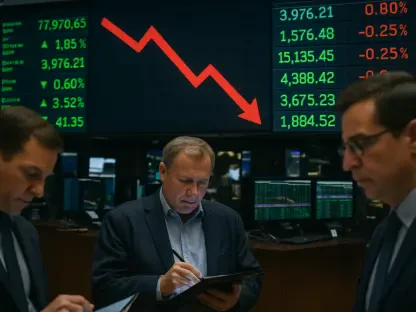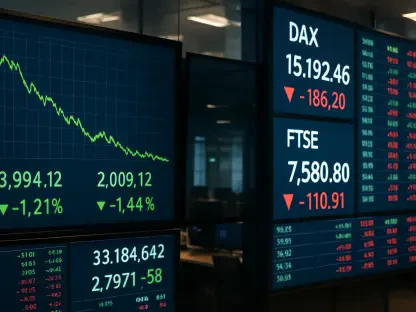As of November 2025, the financial world is gripped by a pressing question that continues to dominate discussions among analysts, investors, and policymakers: has the meteoric rise of artificial intelligence (AI) stocks morphed into a speculative bubble that threatens global markets with potential instability? The AI rally, characterized by staggering growth in technology equities, has transformed from a symbol of innovation into a lightning rod for debate. With valuations soaring to unprecedented levels and market concentration risks mounting, skepticism is replacing the earlier wave of unbridled enthusiasm. This phenomenon extends far beyond stock tickers, influencing commodity demand, reshaping investment strategies, and drawing uneasy comparisons to past market frenzies. The implications are vast, potentially affecting everything from equity stability to the raw materials powering AI’s infrastructure. Exploring this complex landscape reveals not only the risks of a possible correction but also the enduring economic shifts driven by AI’s expansion. This discussion aims to unpack the layers of this rally, examining whether the hype is justified or if markets are teetering on the edge of a significant downturn.
Questioning the Sustainability of AI Valuations
The AI rally has redefined financial markets in recent years, propelling tech stocks to heights that once seemed unimaginable. However, as of November 2025, a palpable shift in sentiment is underway, with growing numbers of financial experts casting doubt on the sustainability of this boom. A recent Bank of America Global Fund Manager Survey from October reveals that 54% of institutional investors now consider the AI surge a bubble. This concern is mirrored in market behavior, as the Nasdaq Composite recorded its sharpest weekly decline since April, signaling a retreat from the earlier fervor. Warnings from prominent financial bodies about overstretched valuations further fuel this unease, painting a picture of a market at a critical juncture. The transition from optimism to caution underscores deeper questions about whether the current trajectory of AI stocks can hold or if a painful correction looms on the horizon.
At the heart of this skepticism lie the jaw-dropping valuations of AI-driven companies, which often defy traditional financial logic. Firms like Palantir Technologies are trading at price-to-earnings ratios as high as 700x, implying an extraordinarily long timeline to justify investments based on current earnings. Even high-profile entities like OpenAI, despite generating $4.3 billion in revenue in the first half of the year, reported a staggering $13.5 billion loss during the same period. Such stark disconnects between market value and profitability raise fundamental concerns about the rally’s foundation. These figures suggest that investor expectations may be driven more by speculative hope than by tangible financial performance, amplifying fears that the market is overinflated and vulnerable to a sharp reversal if sentiment sours further.
Risks of Market Concentration and Systemic Threats
Another layer of concern surrounding the AI rally is the unprecedented concentration of market value in a handful of dominant players. Nvidia, with a valuation reaching $5 trillion as of November 2025, accounts for a staggering 8% of the S&P 500 index, making it a linchpin of market stability. This level of dependency on a single company introduces significant systemic risks, as any downturn in Nvidia’s stock could trigger broader market disruptions. Financial leaders from institutions like Morgan Stanley and Goldman Sachs have issued cautions about potential drawdowns ranging from 10% to 20% over the next 12 to 24 months. Such warnings highlight the fragility of a market so heavily reliant on a few key names, raising the stakes for investors who have poured capital into these giants. The concentration risk serves as a stark reminder of the potential for cascading effects if confidence in these titans begins to waver.
Beyond individual companies, the systemic implications of this concentration are drawing scrutiny from hedge fund managers and analysts alike. Notable figures like Michael Burry, known for predicting past market crashes, have taken substantial positions against AI stocks, drawing parallels to the dot-com bubble of the late 1990s. The fear is that a correction in the AI sector could ripple through the broader economy, impacting sectors far removed from technology. This vulnerability is compounded by the sheer scale of capital tied to these stocks, with AI-related equities losing over $800 billion in market value in early November alone. As markets grapple with these risks, the specter of a broader downturn looms large, prompting a reevaluation of exposure to high-growth tech and a search for safer ground amidst the uncertainty.
Investor Shifts Toward Defensive Assets
Amid mounting concerns over a potential bubble, a noticeable pivot is occurring in investment strategies as capital flows from speculative tech stocks to more stable, defensive assets. Sectors such as Consumer Staples are emerging as favored destinations, with companies like Coca-Cola and Procter & Gamble benefiting from consistent consumer demand and reliable dividend payouts. These industries offer a buffer against the volatility plaguing tech-heavy portfolios, attracting investors seeking to preserve capital in turbulent times. The rotation into these safer havens reflects a broader “risk-off” mentality, as the financial community braces for potential corrections in overvalued AI equities. This shift underscores a growing preference for stability over the high-growth promises that once dominated market narratives.
Utilities also stand out as a key area of interest, with firms like Duke Energy drawing attention for their regulated, predictable cash flows. Similarly, Healthcare companies such as Gilead Sciences provide resilience due to the non-discretionary nature of medical demand, making them appealing in uncertain markets. Select Real Estate Investment Trusts (REITs) further complement this defensive trend, offering inflation-linked income and lower volatility compared to tech stocks. The appeal of these sectors lies in their ability to weather economic storms, providing a stark contrast to the high-stakes gamble of AI investments. As market volatility intensifies, evidenced by sharp declines in indices like the Nasdaq, this flight to safety signals a profound change in investor priorities, emphasizing preservation over aggressive growth.
Commodity Surge Driven by AI Infrastructure Needs
The influence of AI extends well beyond equity markets, driving a remarkable surge in demand for commodities tied to the technology’s infrastructure. Data centers, the backbone of AI computation, are projected by Goldman Sachs to increase global power demand by 165% by 2030 compared to levels from two years prior. This escalating energy need is boosting interest in natural gas, uranium for nuclear power, and even coal in certain regions where renewable options lag. The scale of this demand underscores AI’s transformative impact on the energy sector, creating a ripple effect that reshapes resource allocation worldwide. Even as equity valuations face scrutiny, the physical requirements of AI systems ensure that energy commodities remain a focal point for sustained investment and growth.
In addition to energy, the physical build-out of AI infrastructure is fueling demand for construction materials and critical minerals. Concrete and steel are in high demand for new facilities, while rare earth minerals—essential for semiconductor production—face intense competition. China’s control over 70% of the global rare earth supply introduces significant supply chain vulnerabilities, particularly as export controls tighten amid geopolitical tensions. These dynamics suggest that commodity demand will remain robust, even if AI stock valuations cool. The ongoing and planned expansion of data centers worldwide indicates that the material needs of AI are a long-term trend, insulated from short-term market fluctuations and poised to influence global trade patterns for years to come.
Echoes of Past Bubbles and Regulatory Hurdles
Drawing parallels between the current AI rally and historical market frenzies offers a sobering perspective on today’s environment. The dot-com bubble of the late 1990s serves as a frequent reference point, with striking similarities in investor enthusiasm for revolutionary technology and valuations detached from immediate profitability. While some analysts contend that AI companies boast stronger revenue streams and balance sheets compared to their dot-com predecessors, the persistent gap between hype and tangible results fuels caution. This historical lens highlights the risk of speculative excesses, reminding markets of the painful corrections that followed past periods of unchecked optimism. The comparison serves as a cautionary tale, urging a closer examination of whether current fundamentals can support the lofty expectations embedded in AI stock prices.
Compounding these concerns are the regulatory challenges that loom over the AI landscape, adding layers of uncertainty to an already volatile situation. Governments across the globe are wrestling with complex issues surrounding AI ethics, data privacy, and antitrust actions against major tech players. These policy debates could reshape the competitive environment, potentially curbing the unchecked growth of dominant firms. Additionally, geopolitical frictions, particularly between the US and China over technology supply chains, threaten to disrupt access to critical resources and markets. Such tensions amplify the risks facing AI companies, as policy shifts could alter the trajectory of the rally. Navigating this web of regulatory and international challenges requires vigilance, as outcomes could significantly impact market confidence and long-term growth prospects.
Long-Term Prospects and Strategic Adaptations
Despite the immediate risks and bubble speculation, the long-term outlook for AI remains overwhelmingly positive, with profound economic implications on the horizon. Projections estimate that AI could contribute between $13 trillion and $19.9 trillion to global GDP by 2030, driven by productivity gains and widespread adoption across industries. Innovations such as autonomous “agentic AI” systems and multimodal models are anticipated to accelerate this integration by 2026, transforming sectors from healthcare to logistics. This enduring potential provides a counterbalance to short-term volatility, suggesting that even a market correction might not derail AI’s broader economic impact. The focus on transformative applications highlights why many stakeholders remain committed to the technology, viewing current challenges as temporary hurdles rather than insurmountable barriers.
Strategically, companies are adapting to this evolving landscape by prioritizing value over sheer volume in AI deployment. Emphasis is shifting toward measurable returns on investment, alongside investments in talent development and ethical governance to address public and regulatory concerns. This pivot reflects a maturing approach to AI integration, aiming to align innovation with sustainable business models. While scenarios ranging from steady growth to severe market corrections are possible, the persistent demand for AI infrastructure—particularly in energy and materials—offers a stabilizing factor. For investors and firms alike, the path forward involves closely monitoring valuation trends, policy developments, and geopolitical shifts. Balancing short-term caution with long-term optimism will be key to navigating the uncertainties of this dynamic and rapidly changing market environment.









